Table of Contents
1 Mark Questions
Question 1. Mention any two characteristics of sub-urbanisation. (All Indio 2015)
Answer: The characteristics of sub-urbanisation are as follows:
- It is a trend in which people move away from congested urban areas to cleaner areas outside the city in search of a better quality of life.
- Important suburbs develop around cities.
Question 2. Name the rural settlement pattern of the world, where several roads converge. (Delhi 2010)
Answer: The star-like pattern is one such pattern that develops along the roads spreading outward from the centre where several roads converge.
Question 3. Name the rural settlement pattern that develops around lakes or ponds in the world. (Delhi 2010)
Answer: The circular pattern develops around water bodies i.e. lakes or ponds and takes a circular shape of the rural settlement.
Question 4. What was the percentage of the urban population in the world in 2001? (Delhi 2010)
Answer: The percentage of the world’s population living in urban areas was 48% in 2001.
Question 5. What is the meaning of rural settlement? (All India 2008)
Answer: Rural settlements are most closely and directly related to land and are dominated by
Question 6. “There is no consensus on what exactly defines a village or a town.” Analyse the statement by using different criteria. HOTS; (Delhi 2016)
Answer: It is widely accepted that settlements can be differentiated in terms of rural and urban, but there is no consensus on what exactly defines a village or a town. Although population size is an important criterion, it is not a universal criterion as:
- Many villages in densely populated countries like India and China have a population exceeding that of some town of western Europe and united states.
- Large sections of urban populations prefer to live in villages even though they work in the city.
- Primary occupation is preferred in a village while the secondary and tertiary sector is preferred in a village.
Question 7. Study the diagram given below and answer the questions that follow. (Delhi 2016)
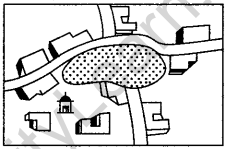
(i) Identify and name the pattern of rural settlement.
(ii) In which type of areas do we find such settlement patterns?
(iii) Give an important characteristic of this type of settlement pattern.
Answer:
(i) The pattern is a circular rural settlement.
(ii) Such type of settlements is found around a lake or tank.
(iii) An important characteristic is that the village is planned in such a way that the central part remains open and can be used for keeping animals to protect them from wild animals.
Question 8. Study the given diagram and answer the questions (Delhi 2016)

(i) Identify the name of the given rural settlement pattern.
(ii) In which type of areas do we find such type of settlement pattern.
(iii) Give an important characteristic of this type of settlement.
Answer:
(i) The pattern is cross shape/rectangular pattern.
(ii) Such type of settlements is found in plain areas or wide intermontane valleys.
(iii) An important characteristic is that roads are rectangular and cut each other at right angles.
Question 9. Study the table and answer the questions that follow. (All Indio 2016)
Continent-wise Distribution of Million Cities
| Continent | Early 1950 | Mid 1970 s | Mid 2000 |
| Europe | 23 | 30 | 58 |
| Asia | 32 | 69 | 206 |
| North and Central America | 16 | 36 | 79 |
| South America | 8 | 17 | 43 |
| Africa | 3 | 8 | 46 |
| Australia | 2 | 2 | 6 |
| World Total | 84 | 162 | 438 |
(i) Name the two continents which have shown the lowest growth rate of million cities as compared to others.
(ii) What reason will you assign for this growth rate?
(iii) Give the meaning of a mega city.
Answer:
(i) The two continents are Europe and Australia.
(ii) The reasons are:
- A number of people migrating from rural to urban areas is less.
- The rural areas have public facilities and job opportunities so people do not migrate to cities.
(iii) A megacity is an urban settlement which accommodates more than 10 million population.
Question 10. Study the given table and answer the questions that follow. (All Indio 2016)
Continent Wise Distribution of Million Cities
| Continent | Early 1950 | Mid 1970 s | Mid 2000 |
| Europe | 23 | 30 | 58 |
| Asia | 32 | 69 | 206 |
| North and Central America | 16 | 36 | 79 |
| South America | 8 | 17 | 43 |
| Africa | 3 | 8 | 46 |
| Australia | 2 | 2 | 6 |
| World Total | 84 | 162 | 438 |
(i) Name the two continents which have shown the highest growth rate of million cities from 1950 to 2000.
(ii) What could be the reason for such a growth of million cities?
(iii) Give the meaning of a million city.
Answer:
(i) The two continents are Asia and Africa.
(ii) The reason is a migration of people from rural to urban areas is more as public facility and jobs are not available in rural areas.
(iii) A million cities is an urban settlement which accommodates more than 1 million population.
Question 11. Explain any three factors responsible for the location of rural settlements in the world. (Delhi 2015)
Answer: The three factors that affect the location of rural settlements are:
Water Supply Generally, settlements are founded near water bodies like rivers, lakes and springs for water availability as water is needed for drinking, cooking, irrigation, etc. Water bodies provide fish as a food source and they are navigable too.
Land Fertile land is preferred by the people for the settlements because fertile lands are best suited for agriculture in Europe. Villages are found near the rolling country, avoiding swampy, low lying land whereas, in South-East Asia, people are located near low
lying river valleys and coastal plains, best suited for rice cultivation.
Upland It is chosen for settlement because it prevents damage to houses and loss of life by a flood. It is a basically drypoint which prefers to settle on terraces and levees. People in tropical countries make their houses on stilts near marshy lands to avoid flood, insects and animal pests.
Also Check: CBSE Class 12 Date Sheet 2024 Out
Question 12. Explain with example the ‘population size’ criteria used by most countries to define an urban area. (All indin 2015)
Answer: The population size criteria used by most countries to define urban areas varies from country to country as there is no universal standard. These variations are:
- In Columbia, it is designated to be 1500.
- In Argentina and Portugal, it is 2000.
- In the USA and Thailand, it is 2500.
- In India, it is 5000.
- In Japan, it is 30,000.
- In Denmark, Sweden and Finland, places with a population size of 250 people are called urban.
- In Iceland, it is 300.
- In Canada and Venezuela, it is 1000.
Question 13. Explain with examples any three features of rural settlement of the world. (Delhi 2010)
Answer: Features of rural settlements are as follows:
- Rural settlements are dominated by primary activities so they are concentrated in fertile lands, e.g. in South-East Asia, people choose to live along low lying river valleys and plains.
- Rural settlements are concentrated where building materials are easily available, e.g. in African Savanna, mud bricks and in polar regions, ice blocks are used to construct houses.
- Rural settlements are concentrated in uplands which are not prone to flooding and in terraces and levees which are drypoint, e.g. in tropical countries people built houses on stilts near marshy lands to protect themselves from floods, insects and pests.
5 Marks Questions
Question 14. Describe any five patterns of rural settlements in the world on the basis of forms and shapes. (Delhi 2014)
OR
Explain any five patterns of rural settlements in the world with the help of suitable diagrAnswer: (Delhi 2013)
OR
Name five patterns of rural settlements on the basis of forms or shapes developed in different regions of the world. Write one characteristic of each. (Delhi 2011)
Answer: Patterns of rural settlements reflect the way the houses are sited in relation to each other. The site of the village, the surrounding topography and terrain influence the size and shape of a village.
The patterns of rural settlements on the basis of forms and shapes are:
Linear Pattern In such settlements, houses are located along a road, river, canal edge of a valley or along a levee.

Rectangular/ Cross-shape Pattern Such patterns of rural settlements are found in the plain areas or wide intermontane valleys. The roads are rectangular and cut each other at right angles.
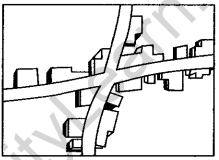
Circular Pattern Circular villages develop around lakes, tanks and some times the village is planned in such a way that the central part remains open and is used for keeping the animals to protect them from wild animals.
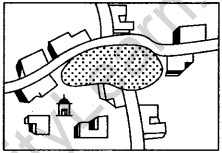
Star-like Pattern Where several roads converge, star-shaped settlements develop by the houses built along the roads.

T-Shaped, Y-shaped, Cross-Shaped or Cruciform Settlements T-shaped settlements develop at tri-junction of the roads while Y-shaped settlements emerge as the places where two roads converge on the third-one and houses are built along these roads. Cruciform settlements develop on the crossroads and houses extend in all the four directions.
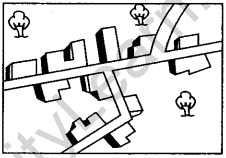
Double Village These settlements extend on both sides of a river where there is a bridge or a ferry.
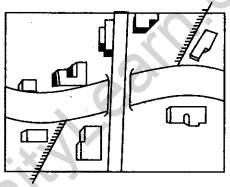
Question 15. Explain any five major problems of the rural settlements in the developing countries of the world.
(All India 2014,2012, Delhi 2012)
OR
Explain the meaning of rural settlements. Describe any four problems related to rural settlements of the world. (All Indio 2010)
Answer: Rural settlements are closely and directly related settlements to land. The primary occupation of these settlements is dominated by agriculture, animal husbandry, fishing, etc. Rural settlements are now facing various problems which are as follows:
Scarcity of Water The villages of developing countries lacks proper water supply. Particularly, people from the mountainous area have to bring drinking water from long distances. Waterborne diseases like cholera and jaundice are prevalent in the villages of
developing countries.
Improper Housing Facilities Houses in the rural areas of the developing countries are not properly ventilated. They are designed in such a way that animal sheds along with its fodder are kept within the houses. Pattern design and building materials are not
according to ecological requirement. For instance, houses in areas prone to heavy rainfalls and flood are made up of mud, wood and thatch.
Lack of General Facilities Lack of sanitation facilities (i.e. toilet facilities garbage disposal facilities, etc) which cause health-related problems.
Lack of Connectivity Road networks is very primitive because roads are unmetalled and lack in a modem communication network. Due to lack of road network, rainy season cuts off the settlement and causes difficulties in providing emergency services.
Lack of Infrastructure Most of the villages has to face serious problems due to poor villagisation and extension of villages over a large area but in a scattered manner. South Asian villages face the situation like flood and drought which also affect the crop cultivation due to lack of irrigation facilities. In the developing countries, rural settlements lack proper infrastructure which causes great challenge and opportunity for planners.
Question 16. Explain any five factors that affect the location of rural settlements of the World. (Delhi 2013,12,08)
Answer: The location of moral settlements is affected by the following factors:
- Water Supply Generally, settlements are founded near water bodies like rivers, lakes and springs for water availability as water is needed for drinking, cooking, irrigation, etc. Water bodies provide fish as a food source and they are navigable too.
- Land Fertile land is preferred by the people for the settlements because fertile lands are best suited for agriculture in Europe. Villages are found near the rolling country, avoiding swampy, low lying land whereas, in South-East Asia, people are located near low
- lying river valleys and coastal plains, best suited for rice cultivation.
- Upland It is chosen for settlement because it prevents damage to houses and loss of life by a flood. It is a basically drypoint which prefers to settle on terraces and levees. People in tropical countries make their houses on stilts near marshy lands to avoid flood, insects and animal pests.
- Building Material Wood and stone used as building material possess another advantage of settlements. Earlier, these villages grew after forest clearing. For instance, cave-dwelling were important in loess (sediment) areas of China. Houses in Africa are made up
- of mud bricks. Similarly, polar regions have Eskimos who build their houses by ice blocks i.e. igloos.
- Defence At the time of political instability, war, the hostility of neighbouring groups, villages were built on hills and island for adherence of defence, e.g. upstanding inselbergs in Nigeria formed good defensive sites. Most of the forts in India are located on highland or hills.
Question 17. Classify urban settlements on the basis of size, functions and services available into five categories and explain an important characteristic of each type. (Delhi 2013)
OR
Name the five types of urban settlements in the world. Write one main feature of each type. (All Indio 2008)
Answer: Urban centres are chosen as a town, city, conurbation, megalopolis, million cities on the basis of size, availability of services and functions. These are the features of urban centres too.
The five types of urban settlements in the world and their main features are as follows:
- Town The concept of ‘town’ can be understood with the act of looking at a village. They specialised in functions such as manufacturing, retail, wholesale, trade and professional services.
- City A leading town which has transformed multi-functions regarded as a city which has become better, greater or larger than local or regional rivals. They foster to have transport terminals, major financial institutions and regional administration offices.
- Conurbation In 1915, Patrick Geddes coined the term conurbation which means separated large area or urban development joining towns or cities. For instance, Greater London Manchester, Chicago and Tokyo.
- Megalopolis In 1957, Jean Gottman popularised the term megalopolis which is a Greek word meaning great city. The term shows the extension of the super metropolitan region as a union of the conurbation. For instance, an urban landscape which is stretching from Boston in the North to the South of Washington in the USA is the best example of a megalopolis.
- Million City The cities in the world are moving and growing day-by-day as never before. For instance, in 1800, London reached the million mark, Paris in 1850, New York in 1860 and in 1950 there was the number of cities crossing the million mark (i.e. 80 such cities). The number of million cities growing with the rate of increase which has been seen in three fold in every three decades.
More Resources for Class 12
- NCERT Solutions for Class 12 Maths
- NCERT Solutions for Class 12 Physics
- NCERT Solutions for Class 12 Chemistry
- NCERT Solutions for Class 12 Biology
- NCERT Books
- NCERT Books for Class 12
Question 18. Classify human settlements of the world into two types by their shapes. Explain any two features of each. (HOTS; All India 2012)
OR
What is a settlement? Classify settlements of the world on the basis of their shape into two categories. Mention any three characteristics of each. (HOTS; All India 2011)
Answer: Human settlement refers to the cluster or group of human houses. These houses may vary from a small hut to a large house of any type or size.
They can be a temporary or permanent inhabited place which might be designed or redesigned. Every settlement is different from other in size, type and function but settlements are moving in continuity with time and space.
Settlements can be divided into two types on the basis of shape:
Compact/Nucleated Settlements
Characteristics of the nucleated/compact settlement are:
- In this type of settlement, houses are built very close to each other.
- It is found along river valleys and in fertile plains.
- People in communities are tied or linked together and share their common occupations.
Dispersed Settlements
Characteristics of dispersed settlements are:
- Houses in this settlement are spaced far apart and often interspersed with fields.
- These are dispersed but binds the settlement together through cultural features such as a place of worship or a market.
- The dispersed settlements are found in the form of few huts in remote jungles, hills with farms or pastures.
Question 19. What are rural settlements? What are the two types of rural settlements in the world? How are they different from each other? Give three points of distinction. (Delhi 2011)
Answer: Rural settlements consist of villages in which most of the people are closely and directly related to land. They are dominated by primary activities. The two types of rural settlements in the world are compact or nucleated settlement and dispersed settlement.
Differences between compact settlements and dispersed settlements are as follows:
| Compact Settlements | Dispersed Settlements |
| Spacing between houses is less as compared to dispersed settlements. | Spacing between houses is more as compared to compact settlements. |
| Fertile plains and river valleys are ideal for the development of this type of settlements. | Forested areas and areas having extreme temperature are ideal for the development of this type of settlements. |
| Compact and congested houses with a narrow street pattern are some features of this type of settlements. | Houses can be seen as isolated huts in remote jungle and hills with large farm and pastures. |
| Usually, people practise cultivation. | Usually, people rear their animals. |
| The population is more and it creates high pressure on available cultivable land. | The population is less and their pressure on land is negligible. |
Question 20. Explain any five major environmental problems related to urban settlements > in the developing countries. (Delhi 2009)
Answer: Environmental problems related to urban settlements are as follows:
- The large urban population in developing countries not only uses but also disposes of a huge quantity of water and all types of waste materials.
- The massive use of traditional fuel in domestic and industrial sectors severely pollutes the air.
- An improper sewerage system creates unhealthy conditions.
- The domestic and industrial wastes are either let into the general sewerage or dumped without treatment at unspecified locations.
- Huge concrete structures created to accommodate the population also generate a lot of heat, thus creating environmental problems.
Question 21. Classify human settlements of the world into two categories. Mention four characteristics of each category. (All Indio 2009)
Answer: There are two categories of human settlement, which are described below:
Rural Settlements They are close to land and have direct contact with the natural environment. Dwellers are mostly engaged in primary activities such as agriculture, fishing and mining. The pressure of population on land is less.
Characteristics of rural settlements are as follows:
- The main economic activities of dwellers are cultivation, fishing, animal husbandry, forestry and other primary activities.
- Houses are built far from each other i.e. spacing between the houses is more.
- Agriculture and other products in rural area support industries of urban areas. Rural area not only supports its population but also of urban areas in terms of food requirement.
- Social bonds in rural areas are one and life is simple.
Urban Settlements Urban settlements are centres of industries and services. Most of the dwellers i.e. about 75% are engaged in these activities. The pressure of population is more on land as they have a high density of population. Towns, cities, etc are examples of urban settlements Characteristics of urban settlements are as follows:
- (z) Unlike rural dwellers, urban people are engaged in secondary, tertiary and quaternary activities such as manufacturing, trade, transport, services, research and development.
- Industries in urban areas are run by the raw material provided by rural areas and in return, they provide finished products and their services to rural people.
- Houses are closely built to each other i.e. spacing between the houses is less.
- Social bonds in urban areas are formal and life is complex, fast and surrounded by various problems.
Map-Based Questions
Question 22. Identify the following on the given political map of the world.
(i) A megacity. (Delhi 2016)
(ii) A megacity, (All India 2016)
(iii) A megacity, (AH India 2015)
(iv) A megacity. (Delhi 2015)
(v) A megacity. (Delhi 2011)
(vi) The important mega city of Pakistan. (Delhi 2009)
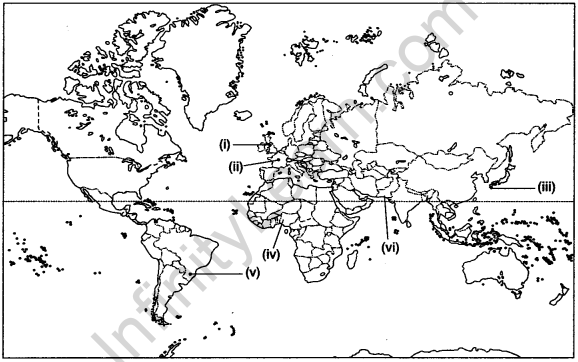
Answer:
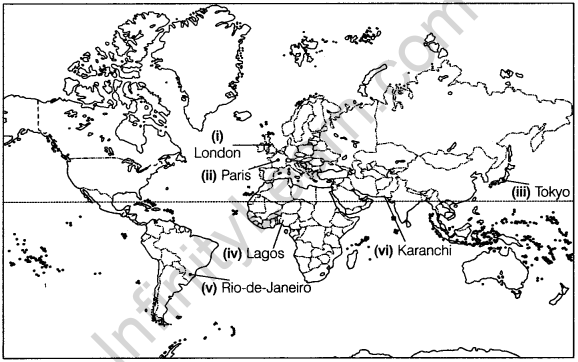
Question 23. Identify the following on the given political map of the world,
(i) A megacity. (Delhi 2012.2008)
(ii) A megacity, (AH India 2011)
(iii) A megacity, (AH Indio 2010)
(iv) The megacity. (Delhi 2010)
(v) The important mega city of Iran. (All India 2009)
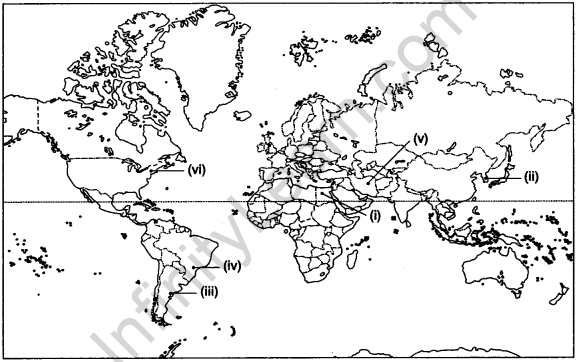
Answer:
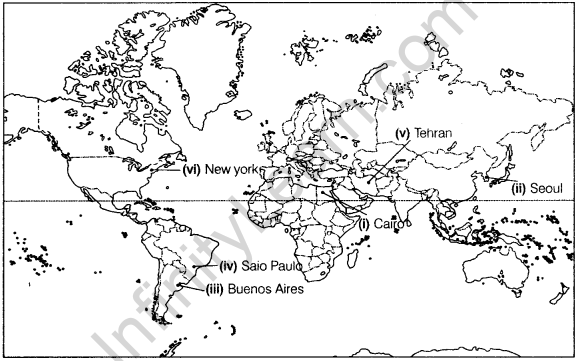
Value Based Questions
Question 24. “People choose to settle near fertile lands suitable for agriculture. In Europe, villages grew up near rolling country avoiding swampy, low lying land while people in south-east Asia chose to live near low lying river valleys and coastal plains suited for wet rice cultivation. Early settlers chose plain areas with fertile soils.” Which value leads to the development of people settlements
Answer: Following values lead to the development of peoples settlement:
- Man-Nature Relationship
- Conservation of Nature
- Culture
Question 25. “It is a new trend people moving away from congested urban areas to cleaner areas outside the city in search of a better quality of living. Important suburbs develop around major cities and every day thousands of people commute from their homes in the suburbs to their workplaces in the city.” Which value motivate people to move away from urban areas?
Answer: Values which motivate people to move away from urban areas are:
- Social Responsibility
- Quality of life
- Awareness towards a good life.



